As more countries amp up their decarbonization efforts, key questions remain about making the shift to electric vehicles. While the expectation is that the majority of charging will be done at home overnight, that won’t always be possible in every case. We collectively understand that infrastructure needs to improve as more people begin using more EVs—but it’s clear that multiple solutions are necessary.
That’s why, in December, 2021, mega automotive conglomerate Stellantis first announced its Arena del Futoro inductive charging project. In 2022, most of us have probably gotten used to the idea of inductive charging for our phones and tablets. We might have inductive charging stations in our homes, or make use of them at coffee shops, airports, and other public places while we’re out. They’ve become so commonplace, we probably don’t even think about them much anymore—we just use them, charge, and go on with our days.
The Arena del Futuro project wants to be that effortless—but it’s taking a different approach. Instead of having to remain in one place, Stellantis and its project partners asked, what if EVs could charge while simply using the road as normal? It’s a potentially game-changing thought—and although that phrase gets thrown around a lot, it seems extremely applicable and not at all like an overstatement in this case. Battery density and range would be much less of an issue the more road like this was available.
It’s now June, 2022—so how is the project going? Very well, the team says. For those unfamiliar, the project relies on what Stellantis is calling its Dynamic Wireless Power Transfer technology (DWPT), which consists of coils positioned directly under the asphalt in the road of the testing loop. Any vehicle outfitted with a special receiver can then draw power from the coils, transfering that power directly to the electric motor and bypassing whatever’s in the battery completely. Thus, the power in the battery is reserved for later use when the vehicle is no longer on an inductive stretch of road.
So far, Stellantis says, its test Fiat New 500 EV has been able to travel at typical highway speeds using DWPT, without using any of the energy stored in its battery. That’s the result found after months of testing, which seems pretty encouraging.
Both the electric Fiat and an IVECO electric bus have so far been involved in testing. No motorcycles have been involved just yet, although this project definitely seems like it could benefit electric motorbikes, as well. During a recent Arena del Futuro event in Chiari, Italy, the team announced that Maserati would be joining the project in the future, and displayed a Grecale Folgore that will soon be part of the testing at the Arena. It will also collect detailed data for performance analysis.
Now, of course, we’ll be even more interested once motorbikes are involved in the testing. (How about a Vespa Elettrica or an Energica? Sure, the Experia has the longest range claim of any Energica yet, but think about how much longer even that could last with power access like this.) Still, it’s encouraging to see regular reports on how projects like this are faring. We look forward to seeing how this one progresses into the future.
Source: Stellantis
Source: Read Full Article
